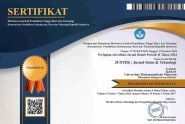Keefektifan Pembelajaran Bahasa Jepang melalui Video Ditinjau dari Motivasi dan Prestasi Belajar Peserta Didik di SMK Negeri 1 Buer Kabupaten Sumbawa
Abstract
Abstract: This study aims to describe: 1) the effectiveness of learning with videos and learning with textbooks and 2) whether learning with videos is more effective than learning with textbooks in terms of students' motivation and achievement in learning Japanese. The population of this study includes all students of class XII SMK Negeri 1 Buer Kab. Sumbawa - NTB which consists of seven classes. A sample of two classes was determined randomly, namely class XII Multimedia (MM) who studied with video and class XII of Computer Network Engineering (TKJ) who studied with textbooks. The instruments used to collect data were a motivational questionnaire to learn Japanese and a Japanese language learning achievement test. To test the effectiveness of learning with videos and learning with textbooks, one sample t test was used at a significance level of 5% and to determine the difference in the effectiveness of learning with videos and learning with textbooks, the Hotelling Trace test (T2) was used at a significance level of 5%, then continued with independent samples t test with Bonferoni criteria at a significance level of 5% to find out which learning media is more effective. The results of this study are as follows: 1) effective video learning in terms of motivation and achievement in learning Japanese, which is indicated by the value of tcount (motivation score) = 7.071 > ttable (0.05;31) = 2.040 and tcount (achievement score) = 33,862 > ttable (0,05;31) = 2,040; 2) learning with textbooks is effective in terms of Japanese language learning achievement, but not effective in terms of motivation to learn Japanese as indicated by the value of tcount (Motivation Score) = 1.223 < ttable(0.05;28) = 2.048 and tcount (Achievement Score) ) = 2.171 > ttable (0.05;28) = 2.048; 3) there is a difference in the effectiveness of learning with videos and learning with textbooks as indicated by the value of Fcount = 11.467 Ftable (0.05; 2; 58) = 3.156 or a probability value of 0.000. Learning with video is more effective than learning with textbooks, which is indicated by the value of tcount (Motivation Score) = 3.885 > ttable (0.025;59) = 2.300 and tcount (Achievement Score) = 2.333 > ttable (0.025;59) = 2.300.
Abstrak: Penelitian ini bertujuan untuk mendeskripsikan: 1) efektivitas pembelajaran dengan video dan pembelajaran dengan buku teks dan 2) apakah pembelajaran dengan video lebih efektif dari pada belajar dengan buku teks dalam hal motivasi dan prestasi siswa dalam belajar bahasa Jepang. Populasi penelitian ini meliputi seluruh siswa kelas XII SMK Negeri 1 Buer Kab. Sumbawa – NTB yang terdiri dari tujuh kelas. Sampel dua kelas ditentukan secara acak, yaitu kelas XII Multimedia (MM) yang belajar dengan video dan kelas XII Teknik Jaringan Komputer (TKJ) yang belajar dengan buku teks. Instrumen yang digunakan untuk mengumpulkan data adalah kuesioner motivasi untuk belajar bahasa Jepang dan tes prestasi belajar bahasa Jepang. Untuk menguji keefektifan pembelajaran dengan video dan pembelajaran dengan buku teks, digunakan satu sampel uji t pada tingkat signifikansi 5% dan untuk mengetahui perbedaan efektivitas pembelajaran dengan video dan pembelajaran dengan buku teks, digunakan uji Hotelling Trace (T2) pada tingkat signifikansi 5%, kemudian dilanjutkan dengan uji sampel mandiri t dengan kriteria Bonferoni pada tingkat signifikansi 5% untuk mengetahui media pembelajaran yang mana lebih efektif. Hasil penelitian ini adalah sebagai berikut: 1) pembelajaran video efektif ditinjau dari motivasi dan prestasi belajar bahasa Jepang, yang ditunjukkan dengan nilai thitung (skor motivasi) = 7,071 > ttable (0,05;31) = 2,040 dan thitung (skor prestasi) = 33.862 > ttable (0,05;31) = 2,040; 2) belajar dengan buku teks efektif dalam hal prestasi belajar bahasa Jepang, tetapi tidak efektif dalam hal motivasi belajar bahasa Jepang seperti yang ditunjukkan oleh nilai thitung (Skor Motivasi) = 1,223 < ttable(0,05;28) = 2,048 dan thitung (Skor Prestasi) ) = 2,171 > ttabel (0,05;28) = 2,048; 3) terdapat perbedaan efektivitas pembelajaran dengan video dan pembelajaran dengan buku teks yang ditunjukkan dengan nilai Fcount = 11,467 Ftable (0,05; 2; 58) = 3,156 atau nilai probabilitas 0,000. Pembelajaran dengan video lebih efektif dibandingkan pembelajaran dengan buku teks, yang ditunjukkan dengan nilai thitung (Skor Motivasi) = 3,885 > ttabel (0,025;59) = 2,300 dan thitung (Skor Prestasi) = 2,333 > ttabel (0,025;59) = 2,300
Keywords
Full Text:
PDFReferences
Adrianti, N. K. A. … Sadyana, I. W. 2020. “Pengembangan Media Pembelajaran Video Bahasa Jepang Berbasis Adobe Flash Untuk Sekolah Dasar Di Bali .” Jurnal Pendidikan Bahasa Jepang 6.
Afgani, M. W. … Purwoko. 2008. “Pengembangan Media Website Pembelajaran Materi Program Linear Untuk Siswa Sekolah Menengah Atas.” Jurnal Pendidikan Matematika 45–59.
Allen, M. J. & Yen, W. M. 1979. Introduction to Measurment Theory. Belmont: Brooks/Cole Publising Company.
Anderman, E. M. & Anderman, L. H. 2009. Psychology of Classroom Learning: An Encyclopedia . Vol. 1. Detroit: Macmillan Reference USA.
Arsyad, A. 2011. Media Pembelajaran. Jakarta: PT. Raja Grafindo Persada. Azwar, S. 2011. Tes Prestasi : Fungsi Pengembangan Pengukuran Prestasi Belajar. 2nd ed. Yogyakarta: Pustaka Pelajar.
Bratasasmita, C. 2019. “Penggunaan Media Videoblog Sebagai Media Pembelajaran Kosakata Untuk Pembelajar Bahasa Jepang Tingkat SMA.” Universitas Pendidikan Indonesia, Bandung.
Burns, M. 1995. Writing in Math Class: A Resource for Grades 2-8. Sausalito: Math Solutions Publications.
Cai, J. … Wong, N.-Y. 2009. Effektive Mathematics Teaching from Teachers’ Perspective. Rotterdam, The Netherlands: Sense Publishers.
Collins III, J. W. & O’Brien, N. P. 2003. The Greenwood Dictionary of Education. London: Greenwood Press.
Dean, J. 2000. Improving Children’s Learning : Effective Teaching in the Primary School. London: Routledge.
Deci, E. L. & Gagné, M. 2004. “Motivation, Intrinsic and Extrinsic” edited by G. R. Goethals, G. J. Sorenson, and J. M. Burns. Encyclopedia of Leadership 3:1036–41.
Departemen Pendidikan Nasional. 2008. Kamus Besar Bahasa Indonesia. Jakarta: Gramedia Pustaka Utama.
Depdiknas. 2006. “Peraturan Menteri Pendidikan Nasional Nomor 22, Tahun 2006, Tentang Standar Isi.”
Dewi, N. W. D. A. 2022. “Pengembangan Media Video Lagu Sebagai Media Pembelajaran Kosakata Bahasa Jepang Pada Siswa Kelas X.” Jurnal Penelitian Mahasiswa Indonesia 2.
Dick, W. & Reiser, R. A. 1989. Planning Effective Instruction /. Englewood Cliffs, NJ: Prentice-Hall, Inc.
Elliot, A. J. & Zahn, I. 2008. “Motivation” edited by N. J. Salkind. Encyclopedia of Educational Psychology 1 & 2:686–92.
Frederick, L. . & Hummel, J. . 2004. “Reviewing the Outcomes and Principles of Effective Instruction” edited by D. . Moran and R. . Mallot. Evidence Based Educational Methods 9–22.
Gordon, P. & Lawton, D. 2003. Dictionary of British Education. London: Woburn Press.
Gronlund, N. . & Linn, R. . 1990. Measurement and Evaluasion in Teaching. 6th ed. New York: Macmillan Publising.
Hamalik, O. 2002. Psikologi Belajar Mengajar. Bandung: Sinar Baru. Hamdani. 2011. Strategi Belajar Mengajar. Bandung: Pustaka Setia.
Heinich, R. … Smaldino, S. E. 2002. Instructional Media and Technologies for Learning. 7th ed. Upper Saddle River, NJ: Merrill Prentice Hall.
Henson, K. T. & Eller, B. F. 1999. Educational Psychology for Effective Teaching. Belmont: Wadsworth Publishing Company.
Kemp, E. J. … Ross, S. M. 1994. Designing Effective Instruction. Belmont: Merrill.
Keraf, G. 1984. Diksi Dan Gaya Bahasa. Jakarta: Gramedia Pustaka Utama. Kridalaksana, H. 2008. Kamus Linguistik. Jakarta: Gramedia Pustaka Utama. Kuncel, N. R. & Klieger, D. M. 2008. “Aptitude” edited by N. J. Salkind.
Encyclopedia of Educational Psychology 1 & 2:47–50.
Lamprianou, I. & Athanasou, J. A. 2009. A Teacher’s Guide to Educational Assessment (Revised Edition). Rotterdam, The Netherlands: Sense Publisher.
Miarso, Y. 1986. Teknologi Komunikasi Pendidikan. Jakarta: Rajawali. Mitchell, T. R. & Daniels, D. 2003. “Motivation” edited by I. B. Weiner. Handbook of Psychology 225–54.
Mueller, C. W. & Kim, J.-O. 1978. Introduction to Factor Analysis What It Is and How to Do It. Newbury Park London: Sage Publications, Inc.
Muijs, D. & Reynolds, D. 2008. Effective Teaching: Teori Dan Aplikasi (Terjemahan Helly Prajitno Soetjipto & Sri Mulyantini Soetjipto). 2nd ed. London: Sage Publication Ltd.
NCTM. 2000. Principles and Standards for School Mathematics. Reston, VA: NCTM.
Nitko, A. J. & Brookhart, S. M. 2011. Educational Assessment of Students. 6th ed.
Boston, MA: Pearson Education, Inc.
Oka, E. R. 2005. “Motivation” edited by S. W. Lee and T. Oaks. Encyclopedia of School Psychology 330–35.
Permatasari, I. 2020. “Penggunaan Media Audio-Visual Untuk Meningkatkan Keterampilan Menulis Karangan Bahasa Jepang.” Universitas Pendidikan Indonesia, Bandung.
Phye, G. D. 1997. Handbook of Classroom Assessment. San Diego: Academic Press Inc.
Qonita, R. 2017. “Pengembangan Situs Media Pembelajaran Bahasa Jepang Dengan Memanfaatkan Video Pada Materi Dasar Bahasa Jepang Di SMAN 1 Jakarta.” Universitas Negeri Jakarta, Jakarta.
Reid, G. 2007. Motivating Learner in the Classroom: Ideas and Strategies.
London: Paul Chapman Publishing.
Rohani, A. 1997. Media Instruksional Edukatif. Jakarta: PT Rineka Cipta. Sanjaya, W. 2008. Perencanaan Dan Desain Sistem Pembelajaran. Jakarta:
Kencana Prenada Media Group.
Santrock, J. W. 2008. Psikologi Pendidikan. (TerjemahanTri Wibowo B. S.).
Avenue of the Amaricas, NY: McGraw-Hill Company, Inc.
Schunk, D. H. … Meece, J. L. 2010. Motivation in Education . Upper Saddle River: Pearson Education, Inc.
Sheldon, K. M. 2007. “Intrinsic Motivation” edited by R. F. Baumeister and K. D. Vohs. Encyclopedia of Social Psychology 1:500–502.
Slavin, R. E. 2006. Educational Psychology. 8th ed. Boston, MA: Pearson Education.
Smith, R. 2002. Creating Effective Primary School: A Guide for School Leaders and Teachers. London: Routledge Falmer.
Soselisa, R. 2012. “Penggunaan Anime Sebagai Media Pembelajaran Kosakata Bahasa Jepang.” Universitas Indonesia, Jakarta.
Stevens, J. P. 2009. Applied Multivariate Statistics for the Social Sciences (5th Ed). Vol. 77.
Sudjana, N. & Rivai, A. 2010. Media Pengajaran. Bandung: Sinar Baru Algesindo.
Sudjianto & Dahidi, A. 2004. Pengantar Linguistik Bahasa Jepang. Jakarta pusat: Kesaint Blanc.
Suhartono, W. E. 2014. “Efektivitas Penggunaan Media Musik Video Terhadap Pembelajaran Kosakata Bahasa Jepang (Penelitian Eksperimen Terhadap Siswa Kelas X Bahasa SMAN 1 Cisarua KBB).” Universitas Pendidikan Indonesia, bandung.
Suparno, P. 1997. Filsafat Konstruktivisme Dalam Pendidikan. Yogyakarta: Penerbit Kanisius.
Suratno, J. 2010. “Pengembangan Dan Penggunaan Sumber Belajar Interaktif Berbasis Komputer Dalam Pembelajaran Matematika SMP.” Universitas Negeri Yogyakarta, Yogyakarta.
Tarigan, H. G. 1986. Pengajaran Kosakata. Bandung: Angkasa.
Taylor, B. M. & Ysseldyke, J. E. 2007. Effective Instruction for Struggling Readers, K–6. Amsterdam Avenue, NY: Teachers College Press.
Uno, B. H. 2010. Theory of Motivation and Its Measurement Analysis in the Field of Education (Teori Motivasi Dan Pengukurannya Analisis Di Bidang Pendidikan).
Watkins, C. … Lodge, C. 2007. Effective Learning in Classrooms. London: Paul Champan Publishing.
Woolfolk, A. 2003. Educational Psychology. 10th ed. Boston: MA: Pearson Education, Inc.
DOI: https://doi.org/10.31764/justek.v5i2.11794
Refbacks
- There are currently no refbacks.
JUSTEK : Jurnal Sains dan Teknologi sudah terindeks
EDITORIAL OFFICE:












.JPG)

